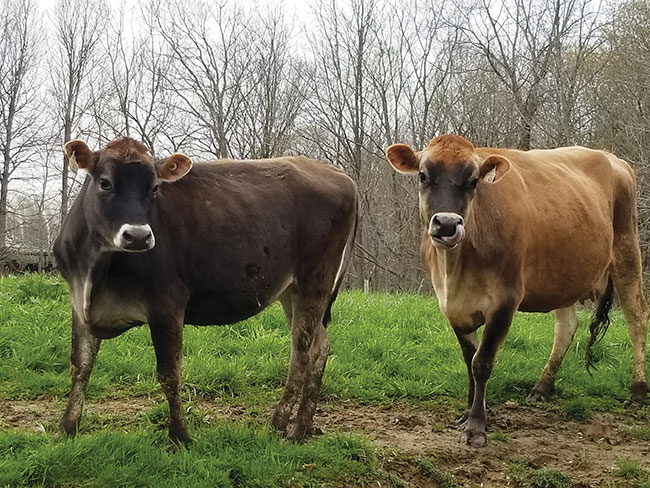
Features
Farm Focus
Jersey Girls
October 11, 2023
By
Bree Rody
How an Ontario farmer keeps his Jersey herd healthy
 The cows at Meadow Lynn frolic during the annual “Who Let The Cows Out” event, which attracts locals and ag enthusiasts.
Image courtesy of Alex Barmard
The cows at Meadow Lynn frolic during the annual “Who Let The Cows Out” event, which attracts locals and ag enthusiasts.
Image courtesy of Alex Barmard For any livestock producer, the herd is their pride and joy.
For Thomas Judd, his parents and his wife Sarah, that pride and joy comes in the form of about 40 milking Jersey cows and a handful of other young stock, heifers and more. Thomas is a fourth-generation farmer, part of the day-to-day operations Meadow Lynn Farms, the farm on which he grew up in Simcoe, Ontario.
“Everybody has their own expertise,” Judd tells The Trough, speaking in terms of his family’s roles on the farm. For his father, K. Fred Judd, that’s largely the crop and commodity side. For his mother, Sharon, that’s mainly the operation of the farm’s strawberries. For Thomas’s wife, Sarah, that’s the community supported agriculture (CSA) program, which has grown modestly every year since its inception. And for Thomas himself, that’s the dairy herd.
Scratch that. The award-winning dairy herd.
Meadow Lynn is most commonly associated with its dairy and with its strawberry farms. Like most farms, it has multiple streams of revenue, and its geographic centrality also provides it with a unique opportunity for engagement. While not exactly an “urban” farm, the property is located well within the boundaries of Simcoe, Ont., only a 10-minute walk from high-traffic areas such as a grocery store, a Tim Hortons and an elementary school. This has allowed Meadow Lynn to engage the public through a number of different avenues, from farm tours and beef sales to pick-your-own strawberries and a yearly “Who Let The Cows Out?” festival in the springtime in which the Jerseys are released onto the pasture for the first time in the year and proceed to frolic and play.
But these playful cows also have some serious bovine bona-fides. The cheerful jerseys are the reason Meadow Lynn and the Judd family were recognized earlier this year by Jersey Canada, the national organization for owners and breeders of Jersey cattle. In April, the Judd family accepted Jersey Canada’s Master Breeder Award. The award is given annually to a farm that displays long-term excellence in breeding Jersey cows – and requires at least 20 years of data.
Jerseys have several advantages for the Judds; Thomas explains: “They have hardened, black hooves, which is a smaller and more densely packed protein so that essentially their hooves hold up better in whatever environment they’re in. You have less hoof injury or infection. That’s a big deal when we’re asking then to travel for water, travel to food, or to get milk.”
Their high energy also means they have monster metabolisms. “Energy-wise, they are more efficient at turning feed into milk,” says Judd, although they don’t make as much milk per cow. While this was seen as a drawback several decades ago, more recent changes in the milk board’s demand requirements for purchasers in the province became more favourable the Jerseys. It enables producers like the Judds to sell by kilogram of fat.
Feeding a healthy Jersey
Jerseys are known for their fat and protein. A body condition score of 2.5 to three is most appropriate for a milking herd – what is referred to as the “Goldilocks” zone.
“We don’t want our cows to be too thin; we don’t want them to be too fat.”
Too fat runs the risk of fatty liver disease with dairy cows, which can make the transition to milking difficult. While transition problems exist on all dairy farms, Jerseys “tend to do quite well,” says Judd, if they’re supported properly.
They sometimes have the challenge of requiring more calcium than a Holstein; they tend to pump more calcium, freeing up calcium within their own systems. Judd says supporting this becomes a challenge for most transition cows.
“We try to mitigate that with feeding a close-up dry cow ration, but it’s always on our radar.”
For feeding the herd, the Judds try to grow as much as they can on the farm in order to maximize its utility. “We try to have the forage be in really good shape, and that helps. That’s the first step in making really good milk.”
Alfalfa haylage is used a base. An on-farm vertical mixer chops the haylage daily. Corn silage is also incorporated. To ensure the top quality of corn silage, Judd says moisture level monitoring is key. Tower silos and a bag system are also used.
“That can provide a bit of a headache,” admits Judd. “It works well until we [can] get bunker silos, which is the five-year project that is always five years away.”
Along with high-moisture corn, starch that is milled on sight adds some balance to the ration. The farm also occasionally uses straw as a rumen agent to promote rumination. The ration is all balanced by a nutrition, and the cows’ diets is supplemented with a small amount of mineral and protein – Judd estimates about four to five tonnes per month.
With their eyes on the future, the Judds also use robotically generated pellets – the pellets have a small protein base and a more significant amount of starch in them that promote travel through the robot. “The robot itself knows how much each cow gives in terms of milk, and thereby doses a comparable feeding of robot pellet.” Every cow that passes through the barn’s robotic milker has a chance for some pellets.

Three generations of Judds stand together after being recognized by Jersey Canada for their breeding excellence.
Image courtesy of Thomas Judd/Meadow Lynn Farms
The ‘central’ concern
The location of Meadow Lynn is also unique. The centrality is a double-edged sword, says Judd. On one hand, the farm’s location has enabled the family to be heavily engaged in the local food scene and capitalize on the town’s fervent “local love.”
“We have many, many more neighbours than your average dairy farm within a small radius,” says Judd.
That proximity to neighbours and the public has informed plenty of decisions with regards to the operation of the farm. “Not only was compost a really good idea for bedding for the cows’ comfort side because there are so many advantages, but there’s also an amazing amount of smell reduction when spreading. There were many challenges that were addressed by going to a compost pack barn.”
More recently, he says, the choice to pivot to an automated milking system was made even easier because of the farm’s highly visible profile. “The perception is reality for some of our [consumer] demographic,” says Judd, who says it’s increasingly common knowledge among consumers that automated milking tech allows cows to be milked voluntarily, and have a thoroughly enjoyable experience being milked. With more consumers pointing a keen eye toward animal welfare – even if some of their views might be biased – Judd says perception is everything. “At any rate, it was the right move for our labour situation, as well as our young family situation, but also for the cows.”
The setting of the farm can also make things tricky for the very nature of playful, energetic Jersey cows.
“During the summer months, we have available pasture for dry cows and heifers. And, of course, because they’re Jerseys, they tend to not like being inside a fence, so that has the additional challenges of seeing your neighbours more often than you’d like to see them while chasing after some Jersey cows.”
Judd acknowledges that for the general public, the image of a frolicking Jersey cow that’s gotten out might bring them some momentary delight, but cautions: “It’s all fantastic until, heaven forbid, one of them gets hit.”
With the town of Simcoe growing and developing – the town’s population grew by 10 per cent to just over 16,000 in 2021, and the broader county grew by 5.4 per cent – Judd also acknowledges that this could impact the future of the farm in some way. But in the meantime, the family is taking advantage of the growing population combined with an increased curiosity about where food comes from.
“That can be a challenge, but it can also be an opportunity,” says Judd. “We see the value, and certainly my wife and I started it with local food. There’s a few on-farm processing opportunities that we’ve talked about that is in the five-year plan. For now, price still rules, but there’s still a pattern toward people understanding the benefit and being prepared to spend a bit more to support local farmers that are offering a local story and local products.”
Print this page